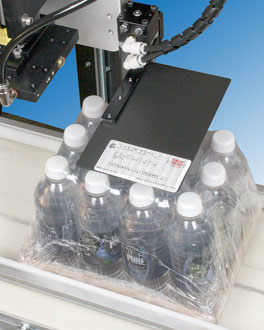5300 RFID Label Printer Applicator
Designed and engineered by Weber, this system provides high-quality smart labeling that will meet the RFID supply chain requirements of major retailers and government agencies, plus ensures precise label printing and application.
The Model 5300rfid offers a selection of thermal/thermal-transfer print-encode engines that produce smart labels imprinted with text, bar codes and graphics at 203 or 300 dpi. Depending upon the print engine selected, smart labels can be up to 5" wide and 6" long and can be dispensed at up to 16 ips.
As a smart label is printed, the Model 5300rfid's integrated encoder simultaneously transfers digital information to the thin, ultra-high frequency (UHF) transponder that is embedded in the pressure-sensitive label material.
That encoded information instantly is verified by the system, which then applies the smart label to the top or side of a carton or pallet load as it moves by on a conveyor line. Labels are applied using the non-contact, tamp-blow method, which gently blows the label onto the surface from 0.25" and is accurate to within 0.03".
The Model 5300rfid also provides XML-enabled printing to permit direct smart label printing and encoding from leading ERP applications.
Pre-Apply Reject
If a tag is not verifiable, the system's unique swing plate automatically is deployed to intercept the smart label prior to application. This method does not alter print engine operation, media handling or dispensing, yet collects and counts the rejected labels for subsequent disposition.
The print engines encode EPC Gen 2 protocols. And because its firmware is upgradeable to support new protocols, users are assured that they can seamlessly upgrade to future RFID protocols as needed.
In addition, Weber is offering special retrofit kits that will enable present users of Model 5300 printer-applicators to upgrade their units to meet the requirements of smart labeling without completely replacing existing systems.
Special Features & Options
The Model 5300rfid system includes a number of noteworthy features that add to the operational versatility of this printer-applicator:
 Model 5300 controller
Model 5300 controller
• Browser-based monitoring. The status of all operational functions and configurations can be monitored by logging on to a web page that is unique to each Model 5300 unit.
• Numerous I/O's. The system can be interfaced with many types of external devices.
• One-to-one media consumption. Special label unwind and rewind dimensions are matched to the system's ribbon supply to ensure they are consumed at the same rate, reducing downtime and eliminating partial changeovers.
• Print job storage. Multiple label printing formats can be stored in the system's memory, making it easier for an operator to select a job directly from the applicator instead of downloading a computer file.
The Model 5300 tire print apply boasts numerous additional features as well, including an upgradeable microprocessor controller, various inputs/outputs, plus durable construction that will withstand harsh industrial environments.
There also are several optional enhancements that can increase the system's functionality. A product height sensor, for example, enables the printer-applicator to label items of varying heights delivered by the same conveyor.
Other options include a 15-foot umbilical connection that enables the remote location of the unit's controller; an adjustable stand for optimum system orientation; label-on-pad and product-presence sensors; plus beacon light alerts to signal the status of label and ribbon supplies.



 Weber's exclusive Model 5300rfid label printer-applicator makes it easy to print, encode, verify and apply pressure-sensitive RFID smart labels to cartons and pallet loads in one automatic operation. In addition, the system determines if a tag is unverifiable and rejects it prior to application.
Weber's exclusive Model 5300rfid label printer-applicator makes it easy to print, encode, verify and apply pressure-sensitive RFID smart labels to cartons and pallet loads in one automatic operation. In addition, the system determines if a tag is unverifiable and rejects it prior to application.



